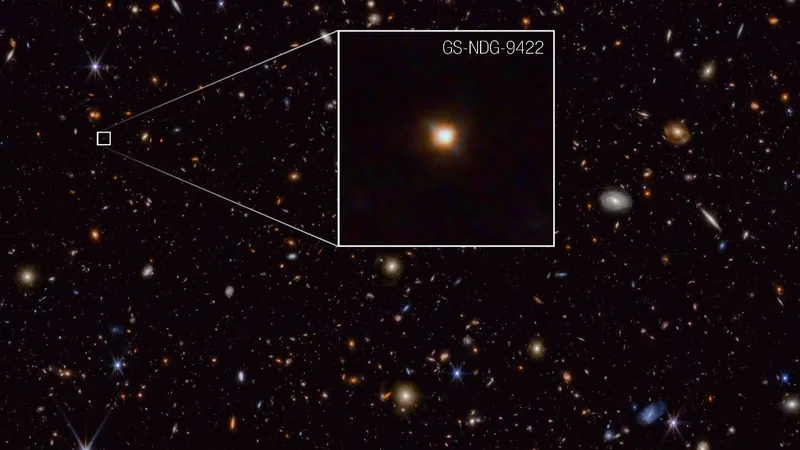
James Webb Telescope Uncovers Rare 'Missing Link' Galaxy from the Early Universe!
2024-09-26
Author: Nur
Introduction
The James Webb Space Telescope (JWST) has made a groundbreaking discovery in the form of a unique galaxy from just one billion years after the Big Bang, a find that could serve as a crucial missing link in our understanding of galactic evolution. Named GS-NDG-9422 (9422), this bizarre galaxy has immense gas clouds that outshine its stars—a phenomenon that scientists believe is linked to the oldest generations of stars.
Observations of GS-NDG-9422
Within GS-NDG-9422, astronomers observed massive stars burning at temperatures nearing 140,000 degrees Fahrenheit (80,000 degrees Celsius), nearly twice as hot as the stars typically found in our local universe. This intense heat results in a cascade of light particles (photons) that bombard surrounding gas clouds, heating them up and causing them to glow brighter than the stars themselves. Such a peculiar trait was once merely a hypothesis among researchers studying ancient stars.
Insights from the Lead Researcher
Lead researcher Alex Cameron from the University of Oxford expressed his surprise upon examining the galaxy's spectrum. "My first thought was, 'that's weird,' which is precisely what the Webb telescope was designed to uncover—entirely new phenomena from the early universe," he stated. The research was published in the October issue of the Monthly Notices of the Royal Astronomical Society.
The Mystery of Population III Stars
Determining when the very first stars began to condense into the galaxies we recognize today has long been a puzzle for astronomers. Cosmologists suggest that this process may have started gradually during the initial few hundred million years post-Big Bang. Yet, the nature of these pioneering stars, often dubbed Population III stars, remains elusive. These stars are theorized to have been incredibly large, extremely bright, and highly efficient heat sources, primarily composed of hydrogen and helium—elements produced during the Big Bang.
The Lifecycle of Massive Stars
As these massive stars rapidly exhausted their fuel, they would end their lifecycles in cataclysmic supernovae, dispersing heavier elements throughout the universe, which are essential for the formation of planets and subsequent galaxies.
Searching for Ancient Stellar Populations
To search for evidence of these ancient stellar populations, the researchers directed the JWST to probe a particularly distant patch of the cosmos. Light from distant objects takes time to reach us, meaning that by looking deeper into the universe, astronomers are effectively looking back in time. This approach led to the identification of galaxy 9422 and its extraordinary stars.
Analysis of Galaxy 9422
However, the analysis indicates that GS-NDG-9422 does not contain Population III stars. "The Webb data shows too much chemical complexity for that," explained Harley Katz, another cosmologist at Oxford. "But the stars are unlike anything we are familiar with, and they could illuminate our understanding of how galaxies transitioned from these primordial stars to the familiar types we see today."
Future Research and Exploration
As researchers continue to study this 'missing link' galaxy, they are eager to uncover more about the early universe. This endeavor includes searching for additional examples of this extraordinary star type to determine how prevalent it was during the nascent stages of cosmic history.
Conclusion
"It's an exciting time for astronomical discovery. The Webb telescope allows us to explore the uncharted territories of the universe's early years," Cameron remarked, looking forward to a wave of new findings that could reshape our comprehension of the cosmos.
Stay Tuned!
Stay tuned for more revelations from the James Webb Space Telescope as it uncovers the mysteries of the universe and redefines our understanding of cosmic evolution!

 Brasil (PT)
Brasil (PT)
 Canada (EN)
Canada (EN)
 Chile (ES)
Chile (ES)
 Česko (CS)
Česko (CS)
 대한민국 (KO)
대한민국 (KO)
 España (ES)
España (ES)
 France (FR)
France (FR)
 Hong Kong (EN)
Hong Kong (EN)
 Italia (IT)
Italia (IT)
 日本 (JA)
日本 (JA)
 Magyarország (HU)
Magyarország (HU)
 Norge (NO)
Norge (NO)
 Polska (PL)
Polska (PL)
 Schweiz (DE)
Schweiz (DE)
 Singapore (EN)
Singapore (EN)
 Sverige (SV)
Sverige (SV)
 Suomi (FI)
Suomi (FI)
 Türkiye (TR)
Türkiye (TR)
 الإمارات العربية المتحدة (AR)
الإمارات العربية المتحدة (AR)